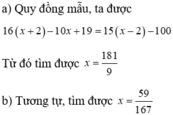Giải các phương trình sau:
a)
b)
Hãy nhập câu hỏi của bạn vào đây, nếu là tài khoản VIP, bạn sẽ được ưu tiên trả lời.



\(a.\left(3x+2\right)\left(x^2-1\right)=\left(9x^2-4\right)\left(x+1\right)\)
\(\Leftrightarrow\left(3x+2\right)\left(x+1\right)\left(x-1\right)=\left(3x-2\right)\left(3x+2\right)\left(x+1\right)\)
\(\Leftrightarrow x-1=3x-2\)
\(\Leftrightarrow2x=1\)
\(\Leftrightarrow x=\dfrac{1}{2}\)
c: =>x-3=0
hay x=3
d: \(\Leftrightarrow\left(3x-1\right)\cdot\left(x^2+2-7x+10\right)=0\)
\(\Leftrightarrow\left(3x-1\right)\left(x-3\right)\left(x-4\right)=0\)
hay \(x\in\left\{\dfrac{1}{3};3;4\right\}\)

\(\left(3x+2\right)\left(x^2-1\right)=\left(9x^2-4\right)\left(x+1\right).\)
\(\Leftrightarrow\left(3x+2\right)\left(x-1\right)\left(x+1\right)-\left(3x-2\right)\left(3x+2\right)\left(x+1\right)=0.\)
\(\Leftrightarrow\left(3x+2\right)\left(x+1\right)\left(x-1-3x+2\right)=0.\)
\(\Leftrightarrow\left(3x+2\right)\left(x+1\right)\left(-2x+1\right)=0.\)
\(\Leftrightarrow\left[{}\begin{matrix}3x+2=0.\\x+1=0.\\-2x+1=0.\end{matrix}\right.\)\(\Leftrightarrow\left[{}\begin{matrix}x=-\dfrac{2}{3}.\\x=-1.\\x=\dfrac{1}{2}.\end{matrix}\right.\)
c: =>(x-3)(x2+3x+5)=0
=>x-3=0
hay x=3
d: =>(3x-1)(x2+2-7x+10)=0
=>(3x-1)(x-3)(x-4)=0
hay \(x\in\left\{\dfrac{1}{3};3;4\right\}\)

\(a,\left(x-1\right)\left(x+2\right)=0\)
\(\Leftrightarrow\left[{}\begin{matrix}x-1=0\\x+2=0\end{matrix}\right.\)
\(\Leftrightarrow\left[{}\begin{matrix}x=1\\x=-2\end{matrix}\right.\)
\(b,\left(x-2\right)\left(x-5\right)=0\)
\(\Leftrightarrow\left[{}\begin{matrix}x-2=0\\x-5=0\end{matrix}\right.\Leftrightarrow\left[{}\begin{matrix}x=2\\x=5\end{matrix}\right.\)
\(c,\left(x+3\right)\left(x-5\right)=0\)
\(\Leftrightarrow\left[{}\begin{matrix}x+3=0\\x-5=0\end{matrix}\right.\Leftrightarrow\left[{}\begin{matrix}x=-3\\x=5\end{matrix}\right.\)
\(d,\left(x+\dfrac{1}{2}\right)\left(4x+4\right)=0\)
\(\Leftrightarrow\left[{}\begin{matrix}x+\dfrac{1}{2}=0\\4x+4=0\end{matrix}\right.\)
\(\Leftrightarrow\left[{}\begin{matrix}x+\dfrac{1}{2}=0\\4\left(x+1\right)=0\end{matrix}\right.\)
\(\Leftrightarrow\left[{}\begin{matrix}x=-\dfrac{1}{2}\\x=-1\end{matrix}\right.\)
\(e,\left(x-4\right)\left(5x-10\right)=0\)
\(\Leftrightarrow\left[{}\begin{matrix}x-4=0\\5x-10=0\end{matrix}\right.\Leftrightarrow\left[{}\begin{matrix}x=4\\x=2\end{matrix}\right.\)
\(f,\left(2x-1\right)\left(3x+6\right)=0\)
\(\Leftrightarrow\left[{}\begin{matrix}2x-1=0\\3x+6=0\end{matrix}\right.\Leftrightarrow\left[{}\begin{matrix}x=\dfrac{1}{2}\\x=-2\end{matrix}\right.\)
`a,(x-1)(x+2)=0`
\(\Leftrightarrow\left[{}\begin{matrix}x-1=0\\x+2=0\end{matrix}\right.\)
\(\Leftrightarrow\left[{}\begin{matrix}x=1\\x=-2\end{matrix}\right.\)
`b,(x -2)(x -5)=0`
\(\Leftrightarrow\left[{}\begin{matrix}x-2=0\\x-5=0\end{matrix}\right.\)
\(\Leftrightarrow\left[{}\begin{matrix}x=2\\x=5\end{matrix}\right.\)
`c,(x +3)(x -5)=0`
\(\Leftrightarrow\left[{}\begin{matrix}x+3=0\\x-5=0\end{matrix}\right.\)
\(\Leftrightarrow\left[{}\begin{matrix}x=-3\\x=5\end{matrix}\right.\)
`d,(x + 1/2)(4x + 4)=0`
\(\Leftrightarrow\left[{}\begin{matrix}x+\dfrac{1}{2}=0\\4x+4=0\end{matrix}\right.\)
\(\Leftrightarrow\left[{}\begin{matrix}x=-\dfrac{1}{2}\\4x=-4\end{matrix}\right.\)
\(\Leftrightarrow\left[{}\begin{matrix}x=-\dfrac{1}{2}\\x=-1\end{matrix}\right.\)
`e,(x -4)(5x -10)=0`
\(\Leftrightarrow\left[{}\begin{matrix}x-4=0\\5x-10=0\end{matrix}\right.\)
\(\Leftrightarrow\left[{}\begin{matrix}x=4\\5x=10\end{matrix}\right.\)
\(\Leftrightarrow\left[{}\begin{matrix}x=4\\x=2\end{matrix}\right.\)
`f,(2x -1)(3x +6)=0`
\(\Leftrightarrow\left[{}\begin{matrix}2x-1=0\\3x+6=0\end{matrix}\right.\)
\(\Leftrightarrow\left[{}\begin{matrix}2x=1\\3x=-6\end{matrix}\right.\)
\(\Leftrightarrow\left[{}\begin{matrix}x=\dfrac{1}{2}\\x=-2\end{matrix}\right.\)
`g,(2,3x -6,9)(0,1x -2)=0`
\(\Leftrightarrow\left[{}\begin{matrix}2,3x-6,9=0\\0,1x-2=0\end{matrix}\right.\)
\(\Leftrightarrow\left[{}\begin{matrix}2,3x=6,9\\0,1x=2\end{matrix}\right.\)
\(\Leftrightarrow\left[{}\begin{matrix}x=3\\x=20\end{matrix}\right.\)

\(a,=>x^3-2x^2+4x+2x^2-4x+8-x^3+2x-15=0\)
\(< =>2x-7=0< =>x=\dfrac{7}{2}\)
b,\(=>x\left(x^2-25\right)-\left(x+2\right)\left(x^2-2x+4\right)-3=0\)
\(< =>x^3-25x-x^3+2x^2-4x-2x^2+4x-8-3=0\)
\(< =>-25x-11=0\)
\(< =>x=-0,44\)

a) \(\sqrt {{x^2} + 3x + 1} = 3\)
\(\begin{array}{l} \Rightarrow {x^2} + 3x + 1 = 9\\ \Rightarrow {x^2} + 3x - 8 = 0\end{array}\)
\( \Rightarrow x = \frac{{ - 3 - \sqrt {41} }}{2}\) và \(x = \frac{{ - 3 + \sqrt {41} }}{2}\)
Thay hai nghiệm trên vào phương trình \(\sqrt {{x^2} + 3x + 1} = 3\) ta thấy cả hai nghiệm đều thỏa mãn phương trình
Vậy nghiệm của phương trình đã cho là \(x = \frac{{ - 3 - \sqrt {41} }}{2}\) và \(x = \frac{{ - 3 + \sqrt {41} }}{2}\)
b) \(\sqrt {{x^2} - x - 4} = x + 2\)
\(\begin{array}{l} \Rightarrow {x^2} - x - 4 = {\left( {x + 2} \right)^2}\\ \Rightarrow {x^2} - x - 4 = {x^2} + 4x + 4\\ \Rightarrow 5x = - 8\\ \Rightarrow x = - \frac{8}{5}\end{array}\)
Thay \(x = - \frac{8}{5}\) và phương trình \(\sqrt {{x^2} - x - 4} = x + 2\) ta thấy thỏa mãn phương trình
Vậy nghiệm của phương trình đã cho là \(x = - \frac{8}{5}\)
c) \(2 + \sqrt {12 - 2x} = x\)
\(\begin{array}{l} \Rightarrow \sqrt {12 - 2x} = x - 2\\ \Rightarrow 12 - 2x = {\left( {x - 2} \right)^2}\\ \Rightarrow 12 - 2x = {x^2} - 4x + 4\\ \Rightarrow {x^2} - 2x - 8 = 0\end{array}\)
\( \Rightarrow x = - 2\) và \(x = 4\)
Thay hai nghiệm vừa tìm được vào phương trình \(2 + \sqrt {12 - 2x} = x\) thì thấy chỉ có \(x = 4\) thỏa mãn
Vậy \(x = 4\) là nghiệm của phương trình đã cho.
d) Ta có biểu thức căn bậc hai luôn không âm nên \(\sqrt {2{x^2} - 3x - 10} \ge 0\forall x \in \mathbb{R}\)
\( \Rightarrow \sqrt {2{x^2} - 3x - 10} = - 5\) (vô lí)
Vậy phương trình đã cho vô nghiệm

a. 3(x-2)-10=5(2x + 1)
<=> 3x - 6 - 10 = 10x + 5
<=> 3x - 10x = 5 + 6 + 10
<=> -7x = 21
<=> x = -3
b. 3x + 2=8 -2(x-7)
<=> 3x + 2 = 8 - 2x + 14
<=> 3x + 2x = 8 + 14 - 2
<=> 5x = 20
<=> x = 4
c. 2x-(2+5x)= 4(x + 3)
<=> 2x - 2 - 5x = 4x + 12
<=> 2x - 5x - 4x = 12 + 2
<=> -7x = 14
<=> x = -2
d. 5-(x +8)=3x + 3(x-9)
<=> 5 - x - 8 = 3x + 3x - 27
<=> -x - 3x - 3x = -27 + 8 - 5
<=> -7x = -24
<=> x = 24/7
e. 3x - 18 + x= 12-(5x + 3)
<=> 3x - 18 + x = 12 - 5x - 3
<=> 3x + x - 5x = 12 - 3 + 18
<=> -x = 27
<=> x = - 27
a. 3(x-2)-10=5(2x + 1)
<=> 3x - 6 - 10 = 10x + 5
<=> 3x - 10x = 5 + 6 + 10
<=> -7x = 21
<=> x = -3
b. 3x + 2=8 -2(x-7)
<=> 3x + 2 = 8 - 2x + 14
<=> 3x + 2x = 8 + 14 - 2
<=> 5x = 20
<=> x = 4
c. 2x-(2+5x)= 4(x + 3)
<=> 2x - 2 - 5x = 4x + 12
<=> 2x - 5x - 4x = 12 + 2
<=> -7x = 14
<=> x = -2
d. 5-(x +8)=3x + 3(x-9)
<=> 5 - x - 8 = 3x + 3x - 27
<=> -x - 3x - 3x = -27 + 8 - 5
<=> -7x = -24
<=> x = 24/7
e. 3x - 18 + x= 12-(5x + 3)
<=> 3x - 18 + x = 12 - 5x - 3
<=> 3x + x - 5x = 12 - 3 + 18
<=> -x = 27
<=> x = - 27

Bài 1: Giải các phương trình sau:
a) 3(2,2-0,3x)=2,6 + (0,1x-4)
<=> 6.6 - 0.9x = 2,6 + 0,1x - 4
<=> - 0.9x - 0,1x = -6.6 -1,4
<=> -x = -8
<=> x = 8
Vậy x = 8
b) 3,6 -0,5 (2x+1) = x - 0,25(22-4x)
<=> 3,6 - x - 0,5 = x - 5,5 + x
<=> - x - 3,1 = -5,5
<=> - x = -2.4
<=> x = 2.4
Vậy x = 2.4

a.\(x^2-25=8\left(5-x\right)\)
\(\Leftrightarrow\left(x-5\right)\left(x+5\right)-8\left(5-x\right)=0\)
\(\Leftrightarrow\left(x-5\right)\left(x+5\right)+8\left(x-5\right)=0\)
\(\Leftrightarrow\left(x-5\right)\left(x+13\right)=0\)
\(\Leftrightarrow\left[{}\begin{matrix}x=5\\x=-13\end{matrix}\right.\)
b.\(\dfrac{x-2}{x+2}-\dfrac{2\left(x-11\right)}{x^2-4}=\dfrac{3}{x-2}\) ; \(ĐK:x\ne\pm2\)
\(\Leftrightarrow\dfrac{\left(x-2\right)\left(x-2\right)-2\left(x-11\right)}{\left(x-2\right)\left(x+2\right)}=\dfrac{3\left(x+2\right)}{\left(x-2\right)\left(x+2\right)}\)
\(\Leftrightarrow\left(x-2\right)^2-2\left(x-11\right)=3\left(x+2\right)\)
\(\Leftrightarrow x^2-4x+4-2x+22=3x+6\)
\(\Leftrightarrow x^2-9x+20=0\)
\(\Leftrightarrow\left[{}\begin{matrix}x=5\left(tm\right)\\x=4\left(tm\right)\end{matrix}\right.\)

b: Ta có: \(\left\{{}\begin{matrix}\left(x+5\right)\left(y-4\right)=xy\\\left(x+5\right)\left(y+12\right)=xy\end{matrix}\right.\)
\(\Leftrightarrow\left\{{}\begin{matrix}xy-4x+5y-20-xy=0\\xy+12x+5y+60-xy=0\end{matrix}\right.\Leftrightarrow\left\{{}\begin{matrix}-4x+5y=20\\12x+5y=-60\end{matrix}\right.\)
\(\Leftrightarrow\left\{{}\begin{matrix}-16y=80\\-4x+5y=20\end{matrix}\right.\Leftrightarrow\left\{{}\begin{matrix}y=-5\\-4x=20-5y=20-5\cdot\left(-5\right)=45\end{matrix}\right.\Leftrightarrow\left\{{}\begin{matrix}y=-5\\x=-\dfrac{45}{4}\end{matrix}\right.\)